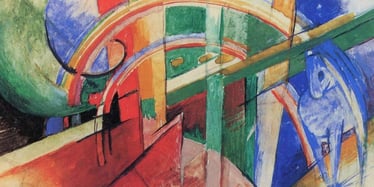German Architecture

Contents
Germany is home to a fascinating array of architectural styles, with city landmark structures, ‘Disney’ castles, and rural historic homes. Traditional timbered German houses and chalets can be found all over the south of the country, whilst Baltic brick homes from the Medieval era are still found in northern towns today. In the cities, a blend of Gothic and Romanesque sits happily alongside Bauhaus, Modernist, and Contemporary buildings.
In the major urban areas, you can expect cathedrals, churches, concert halls, and even libraries design of which will make you gaze upward.
History of Architecture in Germany
The architecture of Germany has a long and diverse history
With over 600 millennia of human history and a space that occupies 357,021 km², Germany doesn’t exactly have one distinct type of architecture. The historic cities such as Berlin, Munich, and Cologne are home to the full timeline of German architectural trends from the pre-medieval Carolingian to Medieval Romanesque, Gothic, Renaissance, Baroque, and the later Neo-Classical and Neo-Renaissance eras.
Whilst these trends existed in cities, those living in rural areas throughout the medieval and early modern era lived in a variety of houses including the Low German House, a farmhouse found in northern Germany and the High German House, a farmhouse more common in Central Germany.
What does Bauhaus mean?
literally translates to ‘Architecture House’. It was a school of art with its heyday lasting from 1919-1933, and it was founded by Walter Gropius.
The early 20th century, gave birth to the Bauhaus movement of art, design, and architecture, which combined arts and crafts, fine art, and functionality. It is the most famous and influential of all German architecture movements.
It was a precursor to Modernist Architecture as a whole, which has flourished in Germany ever since and includes Brutalism, Art Deco, Deconstructivism, and the International styles. Contemporary architecture in Germany features organic design principles and focuses on the concept of sustainability.

Famous German Architects
- Walter Gropius
- Gottfried Bohm
- Max Dudler
- Karl Friedrich Schinkel
Architecture Museums
New residents can find out more about German buildings and the country’s architectural history at the German Architecture Museum in Frankfurt. It’s permanent exhibition, titled From Ancient Huts to Skyscrapers, tells a comprehensive story of German architecture history.
Architecture tours
If you’re fascinated by architecture, why not book yourself in for one of the many architecture tours held in most of Germany’s main cities? To get you started, you can tour the ‘new’ Museum Island in Berlin, the arts district of Munich, or take part in the Cologne: Urbanism: Where Old Meets New tour. Castle tours in Bavaria are also extremely popular.
Characteristics of German architecture
Learn more about the classic style of German architecture and typical German houses
There are vast regional differences when it comes to traditional German architecture, which are evident if you travel around the country. In the Baltic towns and cities, such as Lübeck and Rostock, the Brick Gothic style, which is found all over Northern Europe, has been well-conserved.
To the south, you will find traditional Bavarian Architecture which is more Alpine in style, where homes resemble Swiss chalets.
What are the characteristics of German architecture?
Half-timbered buildings can be found all over Germany, which is a key characteristic of traditional architecture. A-frame roofs are also common, especially in traditional Bavarian homes.
But when you think ‘German buildings’, the magnificent castles of Bavaria might come to mind first. These are also an important, iconic, and well-recognized part of Germany’s medieval history.
What are German houses made of?
Many historic houses are made from brick, especially in the north where there was less rock available throughout history. Half-timbered and fully-timbered houses are common all over Germany, and although these arose in the medieval era, the style was used in rural areas until the 20th century.
Modern homes in Germany are frequently built from a brick masonry formed of sand and limestone, along with asphalt roof tiles. Energy efficiency is important in the building of new homes today, which tend to be well-insulated. A surprising 60% of new homes in German are self-built (prefabricated).
What are German style houses called?
People use a variety of words when they are describing German style homes. This includes log cabins and chalets as well as High German and Low German houses.
Architecture in Berlin
Take a trip to or around Berlin to see for yourself the remains of the famous contrasts between East (GDR) and West German architecture as well as the famous TV Tower or Fernsehturm that’s over 368 meters high and which has a lot more East-West political history than you may have thought!
Famous architectural structures in Germany
These buildings are all worth a visit!
The Semperoper, Dresden
This beautiful Opera House and Concert Hall was originally built in 1841, designed by architect Gottfried Semper. Devasted by a fire, it was rebuilt in 1878 in a Neo-Renaissance design (also known as Revival Renaissance or Dresden Baroque). During the WWII Dresden bombings in 1945, the interior was completely ruined, and it was been largely rebuilt once again. It is considered one of the finest concert halls on Earth.
Cologne Cathedral
A UNESCO World Heritage Site and the most-visited landmark in Germany, Cologne Cathedral is also the seat of the Archbishop of Cologne. It is the tallest twin-spired building in the world and the biggest Gothic building in Northern Europe. Cologne Cathedral is a fine example of German Gothic architecture.
Stadtbibliothek Stuttgart
This public library was only built in 2011 but demonstrates Stuttgart’s continued commitment to modernity, clean lines, and functionalism. Designed by Yi Architects, this 45 x 45 meter cube has perfectly geometric patterned windows on each façade. The interior is white, light, and truly meditative. This public library is a great example of modern German architecture.
Duchess Anna Amalia Library, Weimar
The home of Duchess Anna Amalia (1739–1807) was established as a library during her lifetime. Today, this UNESCO-protected building is a public library and is still home to the Duchess’ own collection of Shakespeare and one of the best collections of German Literature in the country. Located in the so-called Green Castle, the library has a stunning oval-shaped Rococo Hall at its heart.
Hohenzollern Castle, Baden-Württemberg
This imposing castle is a memorial to the two former castles that enjoyed the same hilltop position. The first was built in the 11th century for the House of Hohenzollern. The current, and third, castle was built as a memorial in the mid-1800s. It was inspired by both the English Gothic Revival movement and the French Chateaux of the Loire Valley.
Neuschwanstein Castle, Bavaria
, and the very castle on which the Disney logo is based, this is one of the most famous structures in Germany. It has a classic fairy-tale design and was built in the Romanesque Revival style in 1869. Only a castle in name, it was actually a palace for King Ludwig II in honor of Richard Wagner.
Frauenkirche, Dresden
This Lutheran Church is an excellent example of Baroque architecture. It was built in the 18th century to replace a church that had been in the location previously, and at that time, it had one of the biggest domes in Europe. Built as a testament to the strength of German Protestantism, it sadly suffered in the Dresden bombing of WWII. In recent years it has been rebuilt to its former glory.
Reichstag, Berlin
The home of the German parliament (Bundestag), the imposing Reichstag Building is, for some, the heart of Berlin. Completed in 1894 in a Neo-Renaissance style, the building was later ravaged by both fire and war and has been renovated a number of times. Most notably, it had a glass dome viewing area added in 1999, designed by Norman Foster as a testament to the original cupola of the building.
Elbphilharmonie, Hamburg
One of the world’s newest and most-talked-about concert halls, the Elbphilharmonie is so-named because it was constructed on the banks of the River Elbe. The main body is a glass construction, designed to look like a sail or wave, that sits atop an old warehouse. Referred to by locals as the ‘E±ô±è³ó¾±â€™, it is home to the NDR Elbphilharmonie Orchestra.
Gendarmenmarkt, Berlin
The Gendarmenmarkt Square in Berlin is home to a stunning ensemble of famous German architecture. This includes the 18th century ‘French Church’, the rebuilt ‘German Church’ and the modern Konzerthaus (Concert Hall). In December, the square hosts one of Berlin’s most famous Christmas markets.




















Want to study in Germany?
This might also be of interest to you

German Holidays and Celebrations
Germany enjoys a number of national and regional public holidays and other festivities that take place throughout the year. Those moving to Germany...

Funny German Words
Despite stereotypes of clipped speech and clinical precision, German is an expressive, clever, and often very amusing language. Its dictionary is...

German Art
German artists have always been integral to the story of European art, notably in the movements of Expressionism and Modern Art thanks to the Blue...

German Architecture
Germany is home to a fascinating array of architectural styles, with city landmark structures, ‘Disney’ castles, and rural historic homes....

German Literature
German literature is rich in beautifully crafted stories, especially from the eras of Sturm und Drang, Romanticism, and Realism. Certain German books...

German Sport
Sport is a popular pastime in Germany, both in terms of watching it live and on TV and actual playing and participation. In fact, forty million...

Religions in Germany
Germany is an intercultural and multi-religious country. It's important to understand that apart from main Christian religions (Protestantism and...
